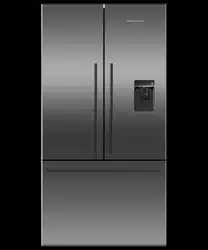Documents: Go to download!
User Manual
- User Manual - (English)
- Data Sheet Freestanding French Door Fridge Freezer - (English)
- Service & Warranty - (English)
- Quick Reference guide - (English)
- Energy Label - (English)
- USING THE CONTROL PANEL
- USING YOUR APPLIANCE
- CLEANING AND CARE
- FOOD CARE
- TROUBLESHOOTING
Table of contents
User manual Refrigerator
USING THE CONTROL PANEL
The control panel enables you to view and modify all the features and options of your refrigerator. Extra features available on selected models.
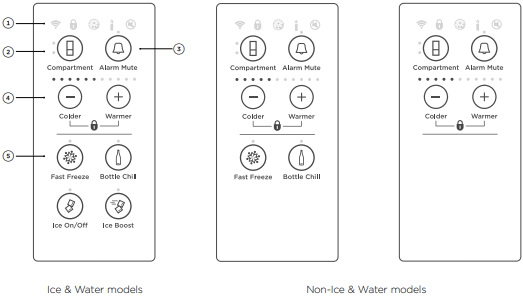
| 1 |  WiFi illuminates when functionality is activated. WiFi illuminates when functionality is activated. |
 Illuminates to indicate that the keys on the control panel are locked. Allows you to disable the buttons on the control panel. Illuminates to indicate that the keys on the control panel are locked. Allows you to disable the buttons on the control panel. |
|
 Illuminates when the water filter needs replacing. Illuminates when the water filter needs replacing. |
|
 IIluminates to indicate that Sabbath mode is activated. IIluminates to indicate that Sabbath mode is activated. |
|
 Illuminates to indicate key press sounds are deactivated. Illuminates to indicate key press sounds are deactivated. |
|
| 2 |
Allows you to select the compartment to adjust the temperature.
|
| 3 | Alarm mute deactivates the door alarm for 20 minutes. |
| 4 | Allows you to adjust the temperature of the selected compartment. |
| 5 |
Allows you to select features:
|
USING YOUR APPLIANCE
Temperature control (all models)
When you turn your refrigerator on for the first time, the cooling system will automatically cool all compartments to their recommended temperatures as displayed by 6 LEDs — 3°C refrigerator and -18°C freezer. This will take between 2-3 hours.
For storage of general household foods in the most efficient manner, it is recommended to use the product in the factory configuration supplied. Moving the shelves and bins will have a minimal impact on efficiency
The internal control panel enables you to change and control the temperature of all compartments accurately and independently. The internal control panel default setting is to show the set temperature for the refrigerator compartment.
For common foodstuffs, the factory default setting provides the optimum setting for foodcare.
How to adjust the temperature — Refrigerator compartment
1.
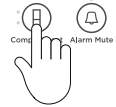
Press  until the refrigerator compartment light is illuminated, indicated by the top light.
until the refrigerator compartment light is illuminated, indicated by the top light.
2.
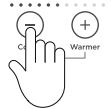
Press + to increase the temperature, press - to decrease the temperature.
How to adjust the temperature — Freezer compartment
1.

Press  until freezer compartment light is illuminated, indicated by the bottom light.
until freezer compartment light is illuminated, indicated by the bottom light.

Press + to increase the temperature, press - to decrease the temperature.
Door alarms
If the refrigerator compartment door is left open, the alarm will beep after 90 seconds, if the freezer door is left open the alarm will beep after 60 seconds. If either of the doors remains open, subsequent beeps will sound every 30 seconds for five minutes.
 Alarm mute
Alarm mute
1.
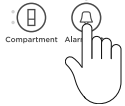
To activate/deactivate ALARM MUTE, press  once. The light above the
once. The light above the  button will illuminate to indicate the refrigerator is muted.
button will illuminate to indicate the refrigerator is muted.
ALARM MUTE will automatically deactivate after 20 minutes or when the door is closed.
 Key mute
Key mute
1.
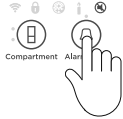
To activate/deactivate KEY MUTE, press  for four seconds.
for four seconds.
Once KEY MUTE is activated the  icon on the internal control panel illuminates, all key sounds are silenced.
icon on the internal control panel illuminates, all key sounds are silenced.
Door alarms and the BOTTLE CHILL alarm are still operational.
 Key lock
Key lock
KEY LOCK allows you to disable the buttons on the internal control panel. This is useful when cleaning your refrigerator.
1.

To activate/deactivate KEY LOCK, press - and + together for four seconds.
When KEY LOCK is activated the  icon on the internal control panel will illuminate.
icon on the internal control panel will illuminate.
Pressing any of the buttons will sound several beeps to tell you that they are disabled.
 Ice On/Off*
Ice On/Off*
ICE ON/OFF activates automatic ice - this is only available in the lower compartment.
Your ice maker is designed to automatically dispense ice into the ice storage bin below until it detects the bin is full. The more ice you use, the more it makes. Before first use the automatic ice systems needs to be flushed.
1.

To activate/deactive, press  . When the ice maker is activated the light will illuminate.
. When the ice maker is activated the light will illuminate.
 Ice Boost*
Ice Boost*
ICE BOOST increases ice production by up to 30% and will automatically deactivate after 24 hours.
1.

When you first turn your ice maker on, ICE BOOST is off.
To activate, press  . The light above the
. The light above the  button will illuminate.
button will illuminate.
ICE BOOST will pause once your ice bin is full.
2.

To manually deactivate press  again. The light will not illuminate.
again. The light will not illuminate.
Activating ICE BOOST will automatically turn on ice making.
Deactivating ice making automatically deactivates ICE BOOST.
Water-dispensing models only
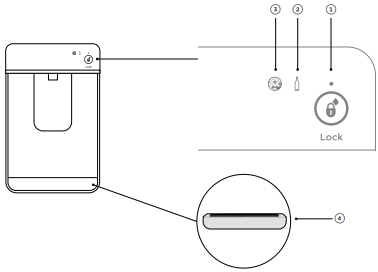
1. Dispenser lock button and LED light
Locks/unlocks the water dispenser. The LED above the lock button will illuminate when dispenser is locked.
2. Bottle Chill indicator
Icon will illuminate when BOTTLE CHILL is activated and flashes when the beverage is ready.
3. Filter change indicator
Icon will illuminate when water filter requires changing.
4. Drip tray
The drip tray is designed to fit into the bottom of the water dispenser panel to capture any odd drips of water that may fall after dispensing.
Dispensing
Your water dispenser is designed for one-handed operation.
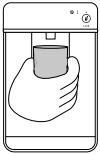
To dispense water, gently press the dispensing pad with a glass or container.
To stop the flow of water, simply pull your glass or container away from the dispensing pad.
Pressing hard against the dispensing pad will not increase the flow or dispense more water.
Flushing the water filter
Before you start using the Ice & Water function, complete the flushing steps to ensure optimum performance of your water filter.
To flush through the water dispenser

Press the water dispenser pad to dispense 4L of water.
Wait for 4 minutes before dispensing again.
Dispense another 4L of water. Your water dispenser is now ready for use.
Water will continue to drip from the dispenser for a few more days after installation as the remaining trapped air is released from the system.
NOTE: There may be carbon residue dispensed together with water. This is not harmful, and normal during flushing process.
To flush through the automatic icemaker
1.

Press and hold  , - and + together for 4 seconds then close the door(s). The ice tray will flip twice and empty the water into the bin below. The ice tray will flip only after the doors are closed. Repeat the cycle to help remove any dust in the ice tray collected during manufacture and transport.
, - and + together for 4 seconds then close the door(s). The ice tray will flip twice and empty the water into the bin below. The ice tray will flip only after the doors are closed. Repeat the cycle to help remove any dust in the ice tray collected during manufacture and transport.
2.

Empty the water in the bin and return the bin correctly. Ensure that the scoop is located in front of the bin.
Once your ice maker is turned on, discard the first 3 harvests of ice (8 cubes per harvest). This will flush away any impurities in the water line and ensure the best ice quality.
Do the above steps after a holiday/vacation or extended periods of not using ice.
CLEANING AND CARE
Exterior
Clean all surfaces with liquid dishwashing detergent dissolved in warm water and a soft cloth. Rinse with clean water and dry with a clean, lint-free cloth.
Do not use any abrasive stainless steel cleaners, glass cleaners, solvents or scourer pads as these will damage the door surface.
Door gasket
Clean the magnetic door gasket every three months with a toothbrush, and liquid detergent dissolved in warm water.
Bottle holder (where fitted)
Clean with warm water and detergent. The use of abrasive cleaners and solvents may cause damage.
Cabinet surround
To maximise operating efficiency regularly vacuum the flooring around your appliance.
Cleaning behind the appliance is required once or twice a year. More frequent cleaning may be necessary for dusty homes or those with pets shedding hair.
To do this wind up the feet and carefully ease the refrigerator out of its position. Switch off and unplug.
Vacuum the flooring behind your appliance and the rear compartment cover (where fitted) to remove dust accumulation. Use a dry lint-free cloth to clean the appliance walls and surrounding cabinetry.
After cleaning, plug in and switch on. Push the appliance into position and wind feet down.

External display and water dispenser (Water-dispensing models only)

Activate the DISPENSER LOCK to prevent water from dispensing when cleaning, refer ‘Dipenser lock’ section for details.
Clean the pad and external display with a damp, soft lint-free cloth.
Drip tray (Water-dispensing models only)
1.

Remove the drip tray from the dispenser panel.
Pull the two halves of the tray apart.
Clean with liquid detergent dissolved in water and a soft lint-free cloth.
Rinse with clean water and dry with a clean, lint-free cloth.
2.

Securely clip the two halves together.
Re-insert the drip tray back into the dispenser panel, rounded sides first.
Interior
It is important to keep the interior of the refrigerator and freezer clean to help prevent food from becoming contaminated during storage.
The amount and types of food stored determines how often cleaning should be carried out in the refrigerator (ideally once every 1 to 2 weeks).
Remove the shelves from cabinet and door. Wash shelves and storage bins in warm water and detergent; rinse in clean water and dry before replacing.
Wipe over the interior surfaces with warm water and liquid dishwashing detergent.
Alternatively you can use 1tsp baking soda dissolved in 500ml of warm water. Rinse with clean water.
To help remove “old stale refrigerator” smells add a few drops of vanilla essence or vinegar to the water before cleaning.
Clean interior surfaces with warm water and liquid dishwashing detergent. Use a toothbrush for the magnetic door gasket.
Do not use harsh, abrasive cloths on any part of the refrigerator or freezer.
Glass shelves
Clean with warm water and detergent.
Bottle holder (where fitted)
Clean with warm water and detergent. The use of abrasive cleaners and solvents may cause damage.
Automatic ice dispenser (Ice & Water and Automatic Ice models only)
We do not recommend you clean the ice maker componentry, but it is important to clean the bins occasionally. The storage bin should be cleaned regularly and the old ice in the bottom of the bin discarded. Wash bin in lukewarm water. Dry thoroughly and replace. When replacing the bin ensure that the scoop is on the right hand side or at the front of the bin (model dependent).
Many commercially available cleaning products contain solvents that may attack the plastic components of your refrigerator and cause them to crack. It is important to use only warm water and a small amount of liquid dishwashing detergent on any components inside and outside your refrigerator. Avoid using anti-bacterial cleaning products on either the interior or exterior of the cabinet as they may cause rusting of metal components and cracking of plastic components.
When cleaning the shelf above the vegetable bins, we recommend that you do not disassemble the Humidity Control System from the shelf.
In the event that the humidity control lid (plastic lid) and humidity slides become separated from the glass shelf, follow these instructions to reassemble.
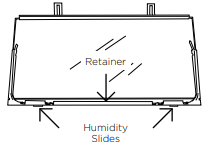
1 Turn shelf upside down.
2 To attach humidity slides onto shelf front corners, fit bottom clips into shelf front trim. Next, slide sideways towards shelf until arm clips onto glass.

3 To attach humidity control lid — with text facing you, align lid with front of shelf. Hold lid vertically and fit front end into retainer on shelf. Ensure lid fits into retainer as well as underneath humidity slides.
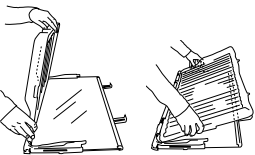
4 At the sides of the shelf, adjust humidity slide tabs so that the plastic lid is between the shelf and the tabs.
5 If clips on back of shelf are present, fasten lid with rear clips. Ensure that the cover is fully secure at front and back of shelf.

To remove trays or fixed bins
- For ease of removal, empty food from tray/bin first.
- Hold the centre front of the tray/bin handle.
- Lift vertically to unclip from the runners and pull tray/bin towards you to remove.
- Push both runners back into refrigerator.
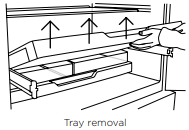
To replace trays or fixed bins:
With the runners pushed back into the refrigerator, place the tray/bin on top of the runners. Push the tray/bin back slowly until you feel it clip back onto the runners.
- Ensure that trays and bins are securely clipped onto the runners before use.
- Bin and tray runners are pre-lubricated, and will not need to be re-lubricated during their life. Do not attempt to clean grease from the runners, as this will affect their ability to function. Do not immerse runners in water.
Permanently fixed bins and trays (Freezer drawer models only)
The freezer bins and trays in this model are permanently fixed. They cannot be removed from the freezer compartment. To clean simply wipe with a soft, damp cloth.
Cleaning the shelf runners
1 Remove all shelving
2 Clean the shelf runner with liquid detergent dissolved in water and a tube brush or a clean lint-free cloth.
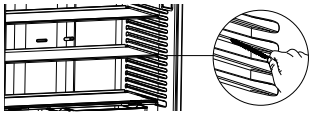
On holiday
- Turn the ice maker to OFF on the internal control panel.
- Shut off the water supply to the refrigerator.
- On your return, turn on the water supply to the refrigerator.
- Dispense 4L of water and discard to ensure the water tank is refilled with fresh water.
- Turn on the ice maker.
- Discard the first 3 harvests of ice (8 ice cubes are produced per harvest).
FOOD CARE
For best food care
- Store only high-quality, fresh food in your appliance.
- Store perishable foods in the appliance immediately after purchase. Storing at room temperature increases the rate of deterioration and can allow harmful microbial growth.
- Storing at temperatures other than settings recommended may impact the storage life.
- Foods such as meat, poultry and seafood should be well wrapped or sealed in suitable packaging to prevent dehydration, color deterioration, loss of flavor, and transfer of odour.
- We recommend storing these foods on the bottom shelf of your appliance or in one of the bins to prevent potential spills and cross-contamination with other foods.
- Ensure hot foods and beverages are cooled sufficiently before placing them into the appliance. Hot items may cause other foods to warm to unsafe temperatures. It may also cause sealed items to sweat/condensate – which is undesirable.
- Beverages are best stored standing upright in the door shelves or on the bottle racks provided.
- Ensure raw and cooked foods are stored separately to avoid cross-contamination.
- Consume food items within the recommended storage times. Discard foods that show sign of spoilage.
- Keep door openings to a minimum to maintain optimum storage temperatures inside your appliance.
- We recommend using FAST FREEZE when you are adding food items to your appliance, such as after grocery shopping. This feature will ensure the food is frozen within the shortest period of time, locking in the freshness and extending the shelf life of your food.
Items stored in your refrigerator
- Dairy items such as butter and cheeses should be stored in the covered door shelf to minimize any transfer of odor or odor absorption from other foods.
- Eggs should be stored in their carton to avoid absorption of strong odors through their porous shell structure.
Items stored in your freezer
- We recommended cooling carbonated beverages only when the BOTTLE CHILL function is active.
- Do not store carbonated drinks without this function in the freezer.
Failure to remove beverages could lead to freezing liquid and the likelihood of bottle/can explosion.
- Ensure air is removed from packaging to avoid large formation of ice crystals and prevent freezer burn.
- To maintain freshness and quality, we recommend defrosting foods in the refrigerator. These foods should not be in contact with fresh foods. Ensure partially or fully defrosted foods are never re-frozen – cook immediately.
Faults
- Count the number of beeps made when the refrigerator compartment door is opened.
- Record the number and sequence of temperature lights displayed on the internal control panel and contact a Fisher & Paykel trained and supported service technician in order to repair the fault. You can do this by going online to fisherpaykel.com or by contacting our Customer Care Centre.
- To silence the fault alarm press any button on the internal control panel.
Normal refrigerator sounds
ActiveSmart™ refrigerators are designed to have excellent energy ratings and cooling performance. As a result, you may hear sounds somewhat different to your old refrigerator.
Normal operational sounds include:
- Fan air flow sound. ActiveSmart™ refrigerators have fans which change speed depending on demand. During cooling periods, such as after frequent door openings, fans circulate the cold air in the refrigerator and freezer compartments producing some air flow sound. This is quite normal.
- Cracking or popping sounds. This may occur when the automatic defrost function is operating.
- Running water sound. This is the liquid refrigerant in the system and can be heard as a boiling or gurgling noise.
- An audible hissing sound after closing the freezer door. This is due to the pressure difference between the warm air that has entered the cabinet and suddenly cooled, and the outside air pressure.
- Humming sounds. This is the compressor running and is quite normal.
- Gasket noises. Normally occur over time due to a build up of dirt and/or grime. See ‘Cleaning and care’ section.
- Ice maker and water dispenser sounds:
- Motor operation (low humming).
- Running water as the ice maker and/or water tank fills.
- Water valve opening and closing (hissing sound).
- Loosened from the ice molding tray (cracking).
- ce dropping into bin (clunking).
- Other sounds may be heard for the following reasons:
- Cabinet not level
- Floor uneven or weak
- Bottles or jars rattling on shelves
TROUBLESHOOTING
If there is a problem with your appliance, check the following points before contacting your local Fisher & Paykel trained and supported service technician or the Customer Care Centre.
Product parts and accessories can be purchased through Fisher & Paykel Customer Care Centre or online at fisherpaykel.com (this service is available to selected markets only).
All models
| PROBLEM | POSSIBLE CAUSES | WHAT TO DO |
| Appliance does not operate | No electricity at power outlet. |
Check that the plug is correctly connected and power switched on. Check another appliance at the same outlet. Check house fuse. |
| Light not working | Light not functioning. | The light cannot be serviced by the user. Contact your Fisher & Paykel trained and supported service technician. |
| Refrigerator not working. | Check refrigerator is turned on at the wall or at the isolating switch. | |
| Motor operates for long periods | for long periods Hot weather. | Minimize door openings to allow temperature to stabilize. |
| Frequent door openings. | ||
| Large amount of food recently added. | ||
| Temperature control set too low. | See ‘Temperature control’ section. | |
| Doors not sealing properly. | Check that cabinet is level and gasket seals are clean. See ‘Cleaning and Care’ section. | |
| Storage compartments too warm | Temperature setting not correct. | See ‘Temperature control’ section. |
| Frequent door openings. | Minimize door openings to allow temperature to stabilize. | |
| Large amount of food recently added. | ||
| Food freezing in the fridge compartment | Temperature setting not correct. | See ‘Temperature control’ section. |
| Food placed directly in front of air outlets. | Move chill sensitive foods away from the center back of the shelves. | |
| Unfamiliar noises | Cabinet not stable or level. | See ‘Installation Guide’ of your appliance. |
| Freezer is defrosting. | This is normal. | |
| Fault alarm sounds when the refrigerator compartment door is opened |
Record the number of beeps along with the number and sequence of temperature lights displayed on the internal control panel. Contact Customer Care Center |
|
| Water in the vegetable bins | Condensation is formed by the water produced by fruit and vegetables. |
A small amount of condensation is beneficial for fruit and vegetable storage. Wipe out water with a cloth. |
| Exterior of cabinet is warm | This is normal. | |
| Condensation on outside of refrigerator/ freezer | Not unusual during periods of high humidity. | Wipe dry |
| Condensation inside fridge compartment | Frequent or long door openings. | Minimize door openings. |
| Door gasket leaking. | Check that gasket is sitting flat and sealing tightly | |
| Not unusual during periods of high humidity | Wipe dry. | |
| Tray/bin does not slide in and out evenly | Packaging trapped. | Check to ensure no food or packaging is trapped behind the tray/bin. |
| Ice cubes taste tainted | Unsealed packages may be transmitting odor/taste. |
Discard ice cubes and clean ice storage bin. See ‘Cleaning and care’ section. Wrap or cover strong smelling foods. |
| Excessive gasket noise | May be due to a build up of dirt and/or grime. | See ‘Cleaning and care’ section. |
| Door not closing | An obstruction is blocking door closing. | Move obstruction. |
Ice & Water models only
| PROBLEM | POSSIBLE CAUSES | WHAT TO DO |
| Automatic ice maker does not work | Ice maker has not been turned on. | Switch on ice maker, see ‘IceOn/Off*’ section. |
| Water supply turned off or not connected. | Connect water supply. | |
| Freezer compartment not working. | Contact Customer Care Center. | |
| Water pressure too low. | Check water pressure. | |
| Water line kinked/squashed. | Check water line for kinks/squashing. | |
| Filter clogged. | Water filter may need replacing. | |
| Ice cubes stick in ice bin. | Remove ice bin, loosen cubes and remove clumped ice. Refit ice box. | |
| Ice cubes taste tainted | Unsealed packages may be transmitting odor/taste. |
Discard ice cubes and clean ice storage bin. See ‘Cleaning and care’ section. Wrap or cover strong smelling foods |
| Poor taste from incoming water. | Replacement filter cartridges can be purchased online from fisherpaykel.com or by calling Fisher & Paykel Customer Care. | |
| Slow ice cube freezing | Door may have been left ajar. | Close door. |
| Freezer compartment set too warm. | Turn temperature to a colder setting. (See ‘Temperature control’ section). | |
| Small cubes | Low water pressure. | Check water pressure. |
| Filter blocked. | Replace filter cartridge. Replacement filter cartridges can be purchased online from fisherpaykel.com or by calling Fisher & Paykel Customer Care. Instructions on how to install your replacement water filter are provided with the filter. | |
| Wet ice/ ice clumping | Long freezer door openings. | Gently tap ice to unstick or, if large clumps occur, empty ice bin and make new ice. |
| High ambient temperature. | ||
| Ice bin left out of freezer compartment for a length of time. | ||
| Ice will stick together over time. | ||
| Water has poor taste/odor | Refrigerator not used for an extended period. | Flush the water filtration system. Dispense and discard 1 gal (4L) of water, this will ensure the water tank is refilled with fresh water. |
| Poor incoming water quality | Refrigerator not used for an extended period. | Flush the water filtration system. Dispense and discard 1 gal (4L) of water, this will ensure the water tank is refilled with fresh water. |
| Water dispenser does not work | Water supply turned off or not connected. | Turn water on. |
| Supply line may be blocked. | Check incoming connection for kinks or leaks. | |
| On first installation there may be air in water system. | To remove air, run 1 gal (4L) of water through the dispenser. | |
| Filter may be blocked and needs replacing. | Replace filter cartridge. Replacement filter cartridges can be purchased online from fisherpaykel.com or by calling Fisher & Paykel Customer Care. | |
| Water frozen in tank | Increase temperature to a warmer setting in refrigerator compartment and freezer. | |
| Water in first glass is warm | Water dispenser not used for extended period. | Discard first glass of water dispensed. |
| Tank capacity used recently. | Allow water time to cool. | |
| Drips overflow drip tray | Air trapped in tank. | Water flow rate has slowed down |
| New filter installed. | ||
| Water flow rate has slowed down | Filter cartridge is restricted. Check if filter icon is illuminating. | Replace filter cartridge. Replacement filter cartridges can be purchased online from fisherpaykel.com or by calling Fisher & Paykel Customer Care. |
| Kinked water supply line. | ||
| Ice buildup inside freezer compartment | Freezer door not closing tightly. | Arrange items in freezer so door can close tightly. |
| Check and clean door gasket seal. | ||
| Ice maker sounds | Normal ice maker operation. | See ‘User warnings and sounds’ section. |
| Small or large ice cubes | Insufficient or excessive water pressure. | Check water pressure. |
See other models: CI302CTB1 RF522ADUSX5 RF411TLPX6 RF402BRYW6 CI302DTB3
 FAST FREEZE
FAST FREEZE ICE ON/OFF
ICE ON/OFF BOTTLE CHILL
BOTTLE CHILL ICE BOOST
ICE BOOST